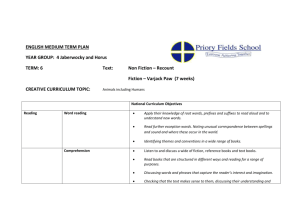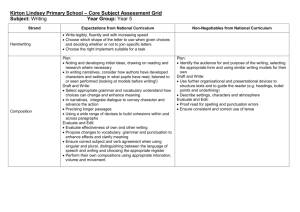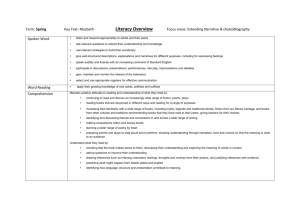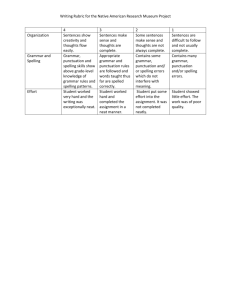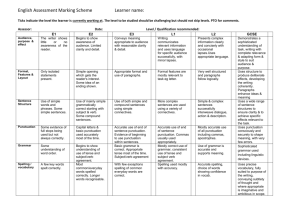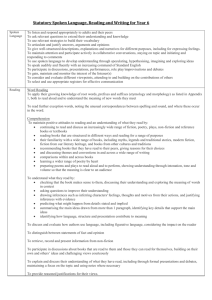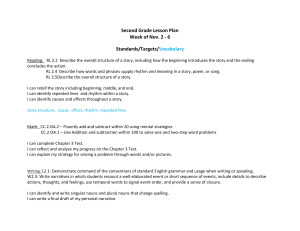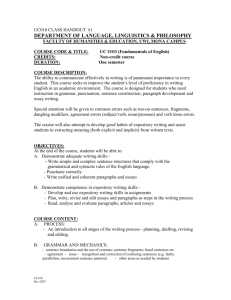progression_process_of_writing_composition_ks1_2
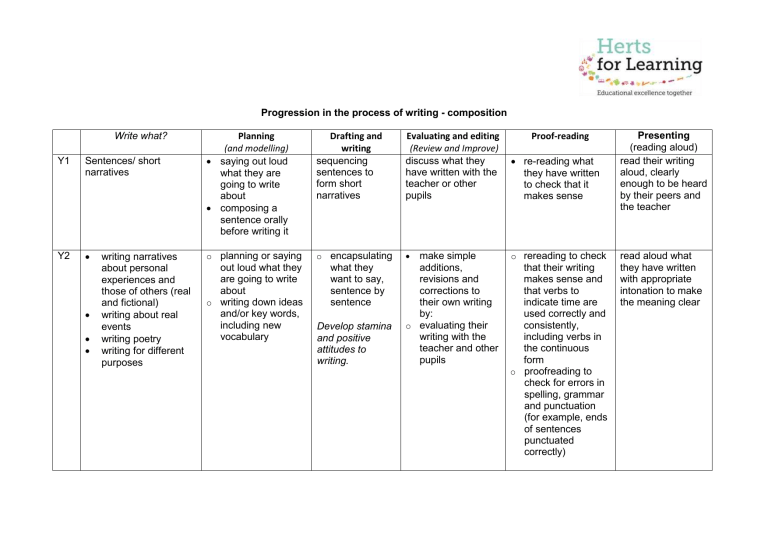
Progression in the process of writing - composition
Y1
Write what?
Sentences/ short narratives
Planning
(and modelling)
saying out loud what they are going to write about
composing a sentence orally before writing it
Drafting and writing sequencing sentences to form short narratives
Evaluating and editing
(Review and Improve) discuss what they have written with the teacher or other pupils
Proof-reading
re-reading what they have written to check that it makes sense
Presenting
(reading aloud) read their writing aloud, clearly enough to be heard by their peers and the teacher
Y2
writing narratives about personal experiences and those of others (real and fictional)
writing about real events
writing poetry
writing for different purposes o o planning or saying out loud what they are going to write about writing down ideas and/or key words, including new vocabulary o encapsulating what they want to say, sentence by sentence
Develop stamina and positive attitudes to writing.
o make simple additions, revisions and corrections to their own writing by: evaluating their writing with the teacher and other pupils o o rereading to check that their writing makes sense and that verbs to indicate time are used correctly and consistently, including verbs in the continuous form proofreading to check for errors in spelling, grammar and punctuation
(for example, ends of sentences punctuated correctly) read aloud what they have written with appropriate intonation to make the meaning clear
Write what?
Y3 and
4 o organising paragraphs around a theme o in narratives, creating settings, characters and plot o in non-narrative material, using simple organisational devices
[for example, headings and subheadings]
Planning
(and modelling)
plan their writing by: o discussing writing similar to that which they are planning to write in order to understand and learn from its structure, vocabulary and grammar o discussing and recording ideas
Y5 and
6 o in narratives, describing settings, characters and atmosphere and integrating dialogue to convey character and advance the action o précising longer passages o using a wide range of devices to build cohesion within and across paragraphs o using further organisational and presentational devices to structure text and to guide the reader [for example, headings, bullet points, underlining]
plan their writing by: o identifying the audience for and purpose of the writing, selecting the appropriate form and using other similar writing as models for their own o noting and developing initial ideas, drawing on reading and research where necessary o in writing narratives, considering how authors have developed characters and settings in what pupils have read, listened to or seen performed
Drafting and writing Evaluating and editing
draft and write by: o composing and rehearsing
(Review and improve)
evaluate and edit by: o assessing the sentences orally
(including dialogue), progressively building a varied and rich vocabulary and an increasing range of sentence effectiveness of their own and others’ writing and suggesting improvements o proposing changes to grammar and vocabulary to improve consistency, including the structures English appendix 2
draft and write by: o selecting appropriate grammar and vocabulary, understanding how such choices can change and enhance meaning accurate use of pronouns in sentences
evaluate and edit by: o assessing the effectiveness of their own and others’ writing o proposing changes to vocabulary, grammar and punctuation to enhance effects and clarify meaning
Proof-read
proofread for spelling and punctuation errors
proofread for spelling and punctuation errors o ensuring the consistent and correct use of tense throughout a piece of writing o ensuring correct subject and verb agreement when using singular and plural, distinguishing between the language of speech and writing and choosing the appropriate register
Presenting
(reading aloud) read their own writing aloud to a group or the whole class, using appropriate intonation and controlling the tone and volume so that the meaning is clear perform their own compositions, using appropriate intonation, volume, and movement so that meaning is clear
Assessment Team 2014
